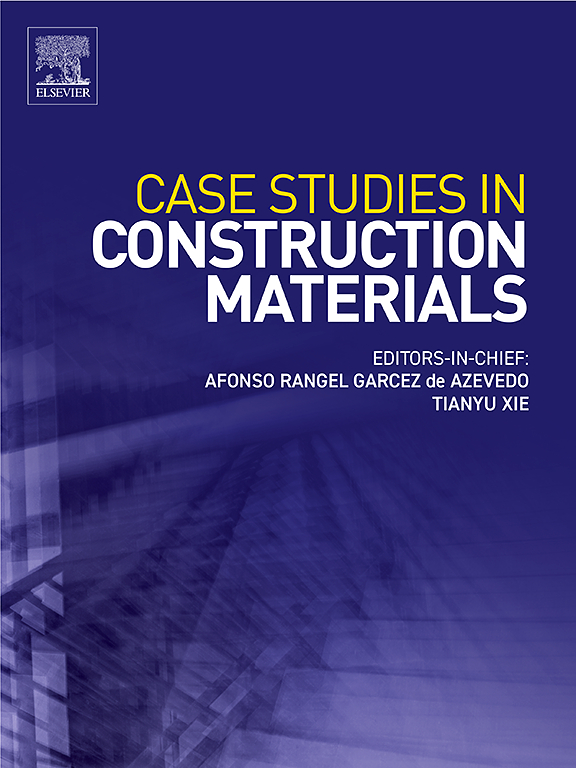改进岩体结构面原位直剪试验及其在顺层边坡稳定性分析中的应用
IF 6.6
2区 工程技术
Q1 CONSTRUCTION & BUILDING TECHNOLOGY
引用次数: 0
摘要
顺层面滑坡是一种常见的岩质滑坡类型,顺层面抗剪强度参数对顺层边坡的稳定性起着至关重要的作用。以往的岩体结构面抗剪强度参数测试多集中在室内试验,不可避免地会受到试样扰动、边界效应、尺寸效应和分级尺度误差的影响。提出了一种改进的原位直剪试验方法,采用适应不同倾角岩体结构面的角度可调调平钢架,测试顺层岩质边坡岩体及其结构面在自然和饱和状态下的抗剪强度参数。试验结果表明:自然状态下岩体抗剪强度参数为:黏聚力c=50.4kPa,摩擦角φ=411°;饱和状态下黏聚力c=34.6kPa,摩擦角φ=41.8°。结构面抗剪强度参数为:自然状态下黏聚力c=49.0kPa,摩擦角φ=27.1°;饱和状态下黏聚力c=24.8kPa,摩擦角φ=28.0°。岩体及其结构面在自然状态下的剪应力-剪切位移曲线表现为应变软化特征,存在一定的脆性损伤,而在饱和状态下的剪应力-剪切位移曲线表现为轻微的应变硬化特征。数值模拟结果表明,无支护边坡处于临界状态,确定了危险结构面。在此基础上,提出了合理的支护方案。研究结论验证了改进的原位直剪试验方法在岩石结构面抗剪强度参数测试中的可行性和有效性。解决了以往原位直剪试验过于复杂、适用性差的问题,能更准确、方便地获得岩石结构面的抗剪强度参数。从而为顺层岩质边坡的评价和支护设计提供了更为合理的参数选择依据。本文章由计算机程序翻译,如有差异,请以英文原文为准。
Improved in-situ direct shear test of rock mass structural plane and its application to stability analysis of bedding slope
Landslides along bedding planes are a common type of rocky landslide, and the shear strength parameters of structural planes play a crucial role in the stability of bedding slopes. Previous tests of shear strength parameters for rock mass structural planes have mostly focused on laboratory experiments, which inevitably suffer from sample disturbance, boundary effects, size effects, and grading scale error. An improved in-situ direct shear test method, utilizing an angle-adjustable leveling steel frame adapted to the rock mass structural planes with different dip angles was developed to test the shear strength parameters of the rock mass and its structural planes in natural and saturated states on a bedding rocky slope. The test results show that the shear strength parameters of the rock mass are: cohesion and friction angle in natural state; The cohesion and friction angle in saturated state. The shear strength parameters of the structural planes are: cohesion and friction angle in natural state; The cohesion and the friction angle in saturated state. The shear stress-shear displacement curves of the rock mass and its structural planes in the natural state show strain softening characteristics with some brittle damage, while the shear stress-shear displacement curves in the saturated state show a slight strain hardening characteristic. The numerical simulation shows that the unsupported slope is in a critical state, and the dangerous structural plane is determined. Based on this, a reasonable supporting scheme is proposed. The conclusion of this study verifies the feasibility and validity of the improved in-situ direct shear test method in the testing of the shear strength parameters of rock structural plane. It solves the problem that the previous in-situ direct shear test is too complicated and has poor applicability, and it can obtain the shear strength parameters of rock structural plane more accurately and conveniently. Hence, it provides a more reasonable parameter selection basis for the evaluation and support design of bedding rocky slope.
求助全文
通过发布文献求助,成功后即可免费获取论文全文。
去求助
来源期刊

Case Studies in Construction Materials
Multiple-
CiteScore
7.60
自引率
19.40%
发文量
842
审稿时长
63 days
期刊介绍:
Case Studies in Construction Materials provides a forum for the rapid publication of short, structured Case Studies on construction materials. In addition, the journal also publishes related Short Communications, Full length research article and Comprehensive review papers (by invitation).
The journal will provide an essential compendium of case studies for practicing engineers, designers, researchers and other practitioners who are interested in all aspects construction materials. The journal will publish new and novel case studies, but will also provide a forum for the publication of high quality descriptions of classic construction material problems and solutions.
 求助内容:
求助内容: 应助结果提醒方式:
应助结果提醒方式:


